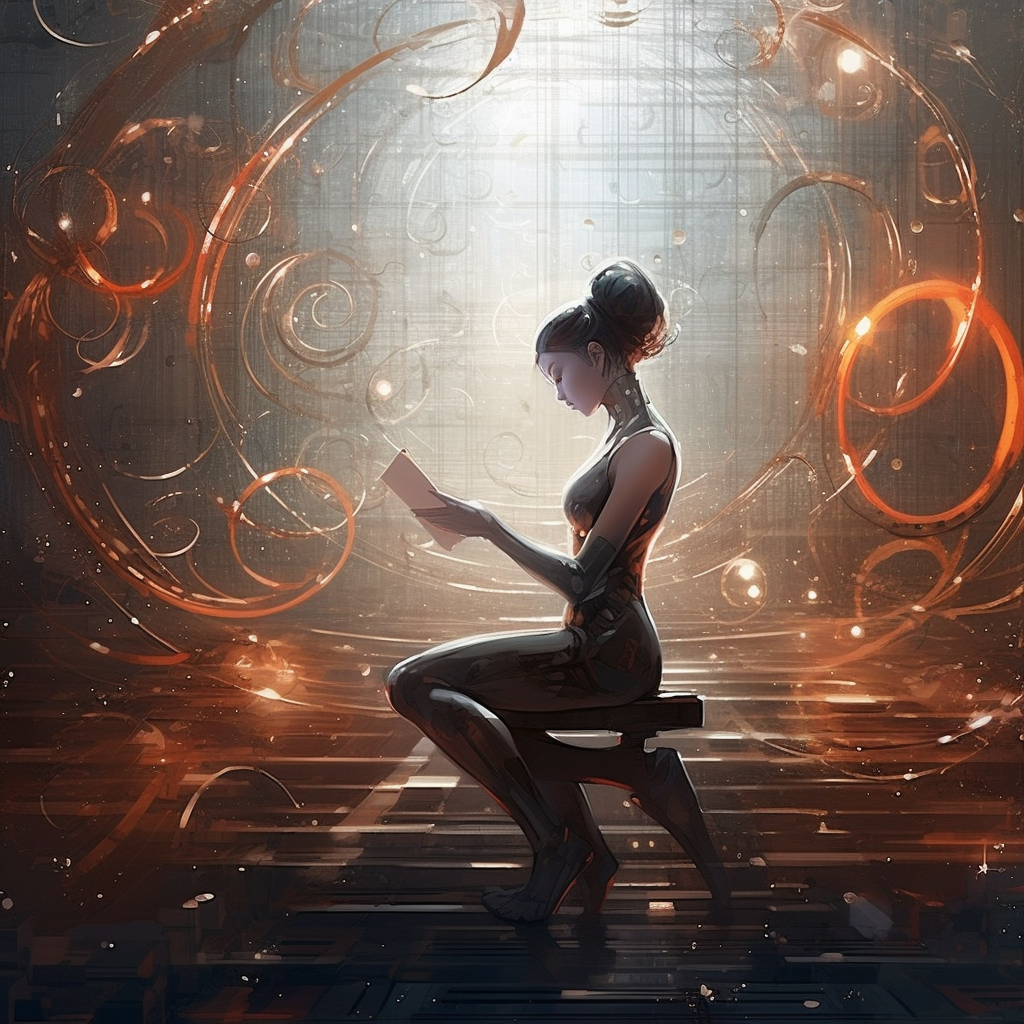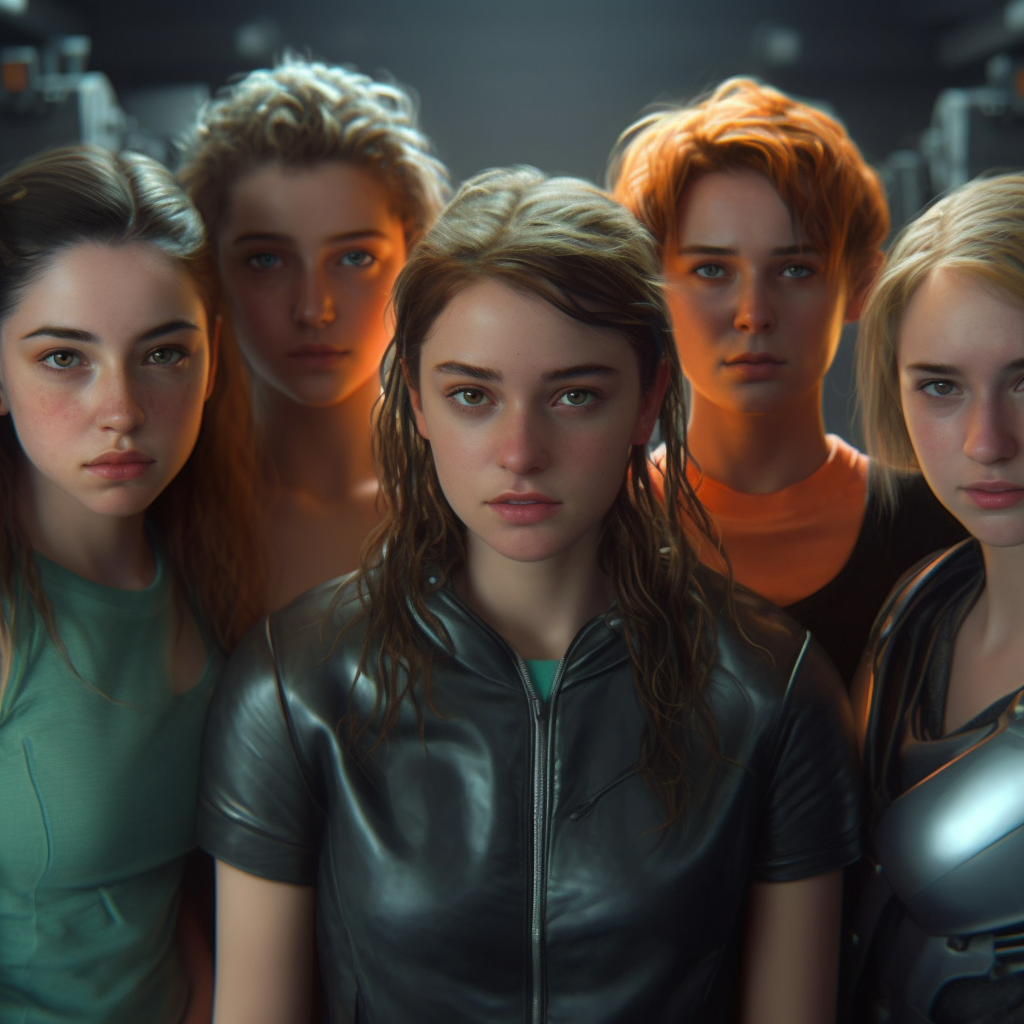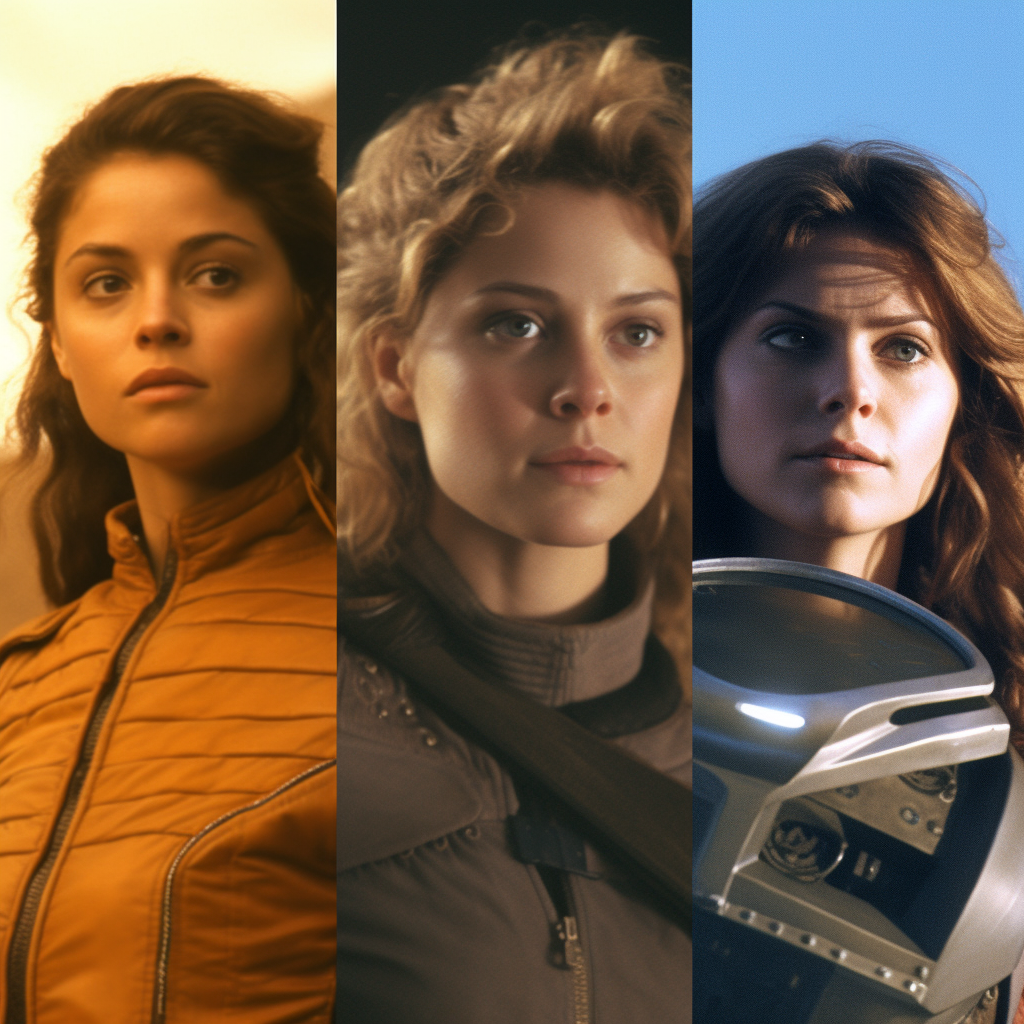In the realm of teenage science fiction, a genre that captures the essence of adolescent adventure and the mystique of the cosmos, there exists a host of characters that have come to define the field: female protagonists. These dynamic figures are not only central to the narratives they navigate but also pivotal in echoing the evolving societal norms and values. This article will delve into the role, impact, and significance of female protagonists in teenage science fiction, uncovering the ways in which they’ve shaped the genre and its avid readers.
The Role and Impact of Female Protagonists in Teenage Science Fiction

One might ask: What is it about these characters that truly captures our imagination? The answer lies in the multifaceted roles they embody and the compelling narratives they drive. For instance, Katniss Everdeen of ‘The Hunger Games’ series is more than a mere survivor. She’s a symbol of rebellion, a reluctant hero thrust into a dystopian world where her bravery becomes a beacon of hope. Characters like Katniss leave a profound impact on the genre, pushing the boundaries of storytelling and character development. They are more than damsels in distress or secondary figures; they are at the forefront, commanding their own narratives and influencing the trajectory of the plot.
Evolution of Female Protagonists in Teenage Science Fiction
In order to fully appreciate the landscape of female protagonists in teenage science fiction today, it’s crucial to trace their evolutionary path. This genre, like many others, has witnessed its own set of transformations over the years, with female characters gradually moving from the margins to the center stage.
Initial Roles of Female Protagonists
Initially, female characters in teenage science fiction were often relegated to supporting roles – damsels in distress waiting for their male counterparts to save the day. They existed more as plot devices than as fully-realized characters. However, with changing societal norms and increasing demand for representation, authors began crafting female characters with greater depth and autonomy.
The Emergence of Central Female Characters
The 1960s and 1970s marked a significant shift in the portrayal of female protagonists in science fiction. Authors like Madeleine L’Engle, with her groundbreaking novel “A Wrinkle in Time,” created female protagonists who were intellectually curious, brave, and central to the narrative. Meg Murry, with her intelligence and resilience, became a beacon of hope for many young girls who saw themselves reflected in her.
The trend of strong, complex female characters continued into the 1980s and 1990s. Lois Lowry’s “The Giver” gave us Fiona, a compassionate and caring character, reflecting the depth and complexity of teenage emotions. Similarly, Jeanne DuPrau’s “The City of Ember” introduced Lina Mayfleet, a courageous and inventive girl who becomes the savior of her city.
Complex Female Characters of the 21st Century
The 21st century brought an even greater shift with series like “The Hunger Games” and “Divergent.” These books presented female characters that were not just strong and resilient, but also deeply flawed, complex, and human. They were leaders, rebels, fighters, and thinkers – embodying a multitude of roles that reflected the diversity of the female experience. Characters like Katniss Everdeen and Tris Prior showed young readers that it was not only okay to be strong and brave, but also to be vulnerable, to make mistakes, and to grow from them.
The Diverse Landscape of Today’s Female Protagonists
Today, female protagonists in teenage science fiction continue to break boundaries. They’re no longer confined to traditional roles or characteristics. They embody a broad spectrum of personalities, backgrounds, and experiences, reflecting the diverse world we live in. From cyborgs like Cinder to prodigies like June Iparis in Marie Lu’s “Legend,” these characters represent much-needed diversity and complexity.
Looking Forward
The evolution of female protagonists in teenage science fiction is a testament to the genre’s capacity for growth and change. It reflects societal shifts and serves as a mirror to our changing perceptions of gender roles and capabilities. As we look ahead, it’s exciting to imagine what the future holds for these female protagonists, given the remarkable journey they’ve already made.
Notable Authors and Their Contributions
An undeniable factor in the rise of compelling female protagonists in teenage science fiction is the contributions of the genre’s luminary authors. Their knack for crafting nuanced and dynamic characters has transformed the way readers perceive heroines in this literary realm.
Let’s start with Suzanne Collins, the mastermind behind the dystopian phenomenon, ‘The Hunger Games.’ Through her protagonist, Katniss Everdeen, Collins defied existing conventions and gave readers a strong, multi-dimensional female lead. Katniss is not just a participant in the dystopian nightmare, but a driving force of rebellion. Her courage, compassion, resourcefulness, and resilience became a rallying cry for readers across the globe, echoing the sentiment of empowerment and resilience. Collins’s artful portrayal of Katniss has not only made a significant impact on the genre but also ignited a spark for strong female leads in young adult literature.
Courageous and self-sacrificing
Then we have Veronica Roth, the author behind the ‘Divergent series. Through her character, Tris Prior, Roth explores the complexities of identity, courage, and societal expectations. Tris is not your average heroine; she’s a deeply flawed character navigating a divisive society while wrestling with her own identity and making life-altering choices. Her journey from a shy, insecure girl to a courageous, self-sacrificing woman resonates with readers, particularly teenagers undergoing similar personal growth. Roth’s depiction of Tris has helped shatter stereotypes, demonstrating that female protagonists can be just as complex and flawed as they are strong and brave.
Marissa Meyer, author of the ‘Lunar Chronicles,’ has also made significant contributions to the portrayal of female protagonists. Her character, Cinder, a cyborg mechanic, takes readers on a journey where the line between human and machine blurs. Cinder’s struggles with self-acceptance, discrimination, and pursuing her dreams amidst societal constraints make her relatable and inspiring. Meyer’s decision to center her narrative around a character often seen on the periphery of society – a cyborg – challenged the status quo and broadened the landscape of female characters in the genre.
These authors have been instrumental in challenging and redefining the representation of female protagonists in teenage science fiction. Their distinct styles and pioneering characters have enriched the genre, empowering a generation of readers while leaving an indelible mark on young adult literature.
Decoding the Power of Ten: Teenage Sci-Fi’s Most Influential Female Protagonists

Zarya from “Zarya: Cydnus Final Hope” by Jackiem Joyner –
The protagonist of the book, Zarya, is a courageous teenager who undertakes a perilous journey to save her home planet, Cydnus. With her AI-powered airboard, Sochi, and her friends, she uncovers and aims to thwart a deadly plot, demonstrating incredible strength, intelligence, and resilience.
Karou from “Daughter of Smoke and Bone” by Laini Taylor –
Karou, a young art student living in Prague, is actually a half-human, half-chimaera. She’s strong, determined, and capable, standing as a bridge between the human world and the world of creatures thought only to exist in mythology.
Ender from “Ender’s Game” by Orson Scott Card –
Despite the character’s traditionally male name, Ender is a non-binary protagonist who displays extraordinary tactical brilliance, being trained to combat an alien threat. Ender’s compassion and moral conflicts, along with their ruthless efficiency, make them a compelling character.
Lilac LaRoux from “These Broken Stars” by Amie Kaufman and Meagan Spooner –
Lilac starts off as a spoiled heiress but evolves through her experiences after surviving a spaceliner crash. She exhibits survival skills, courage, and emotional strength as she and a fellow survivor navigate through an alien planet.
Sissix from “The Long Way to a Small, Angry Planet” by Becky Chambers –
Sissix, an alien from the Aandrisk race, provides a different perspective on what it means to be a female protagonist. She’s a competent pilot and a compassionate friend, adding depth to the story with her unique cultural practices and perception of interpersonal relationships.
Katniss Everdeen from “The Hunger Games” by Suzanne Collins –
Katniss is a resourceful, strong, and determined character who volunteers to participate in the deadly Hunger Games in place of her younger sister. Throughout the series, she exhibits extraordinary bravery, strategic acumen, and a deep care for her loved ones.
Tris Prior from “Divergent” by Veronica Roth
Tris is a fearless character who challenges societal norms. Born into a society that classifies its members into five factions, Tris discovers she is Divergent, fitting into multiple factions, and uncovers a conspiracy to destroy all Divergents.
Hermione Granger from “Harry Potter” by J.K. Rowling
Hermione is a Muggle-born witch who is not only academically brilliant but also brave, loyal, and resourceful. Her quick thinking and vast knowledge often save her friends from dangerous situations.
Alina Starkov from “Shadow and Bone” by Leigh Bardugo –
Alina is a soldier who discovers she has a unique power that could be the key to setting her war-torn country free. She is drawn into the elite world of the kingdom’s magical Grisha, where she struggles to hone her power while dealing with intrigue and danger.
Cinder from “The Lunar Chronicles” by Marissa Meyer
A cyborg mechanic in a society that looks down on her kind, Cinder gets tangled in intergalactic politics when she discovers that she is the lost Lunar princess. Despite facing numerous obstacles, Cinder remains resilient and resourceful.
Case Studies: Compelling Female Protagonists
Every character brings their unique flair to the narrative. They are the lifeblood of the story, driving it forward, and nowhere is this more evident than in the realm of teenage science fiction. Let’s delve into some detailed case studies of noteworthy female protagonists who have left an indelible mark on the genre.
- Katniss Everdeen from ‘The Hunger Games’
Suzanne Collins’ trilogy is arguably one of the most influential series in recent times. At the heart of it all is Katniss Everdeen, a protagonist who is fierce, self-sacrificing, and a true survivalist. Her character growth, from a reserved and cautious individual to a determined and courageous symbol of rebellion, creates an engaging story arc that resonates deeply with readers.
- Tris Prior from ‘Divergent’
Veronica Roth’s ‘Divergent’ series has another compelling character, Tris Prior. Tris’s journey from a timid girl to a strong, resilient woman who challenges societal norms is a testament to the dynamic and intricate development that female protagonists can embody. Her ability to balance compassion with toughness has influenced both the course of the narrative and the genre itself.
Adventure Protagonists
- Hermione Granger from ‘Harry Potter’
While not a science fiction series, J.K. Rowling’s ‘Harry Potter’ provides an essential case study with Hermione Granger. She brings a unique mix of intelligence, bravery, and loyalty, breaking the stereotype of the ‘sidekick.’ Hermione’s academic prowess and moral compass often drive the story forward, asserting the significant role a female protagonist can play.
- Zarya from “Zarya: Cydnus Final Hope”
Authored by Jackiem Joyner, “Zarya: Cydnus Final Hope” presents an engaging narrative driven by a strong female protagonist. At only fifteen years old, Zarya must bear the weight of her planet’s fate. She is courageous, intelligent, and steadfast, setting an inspiring example for young readers.
The story takes place on Cydnus, a technologically advanced desert planet under harsh military control. Here, surveillance and control are the order of the day, but Zarya dares to question and confront this oppressive system when her father mysteriously disappears.
In her quest to find her parents, Zarya uncovers a diabolical plot hatched by the planet’s chief military officer, Gerik, who plans to deploy a lethal weapon that will annihilate the weaker half of the population. The stakes are high, and Zarya becomes the planet’s only hope. She is equipped with Sochi, an AI-powered flying airboard, and accompanied by her friends. Together, they embark on a perilous journey to stop Gerik and save their world.
A thrilling adventure
“Zarya: Cydnus Final Hope” takes readers on a thrilling adventure where a young girl must face overwhelming odds. However, Zarya is no ordinary girl; she is a beacon of courage, ingenuity, and resilience, embodying qualities that every reader can admire and aspire to.
Jackiem Joyner continues the exciting saga of Zarya in the upcoming “Zarya episode 2: Prologue.” This sequel takes off from where the first book ended, promising more thrilling adventures, challenges, and character development. Zarya emerges as the symbol of hope in the aftermath of a conflict that saw Gerik’s dreams of conquest crumble.
As Cydnus’s champion, Zarya must grapple with new dilemmas and threats, from unpredictable AI developments in her loyal companion, Sochi, to her heroic actions attracting unwelcome attention from the formidable Cydnus council. Zarya’s ongoing journey shows that the path to victory is seldom smooth, and heroism often comes with trials that test one’s mettle.
Inspiring and Entertaining
As an author, Joyner has managed to create a powerful and inspirational female lead with Zarya. The narrative not only entertains but also prompts reflection on important themes like courage in the face of adversity, the importance of friendship, and the ethical challenges that come with power and responsibility.
With the promise of more gripping adventures and challenges for Zarya in the upcoming sequel, readers can look forward to further exploring this richly crafted world and its heroic protagonist. Don’t wait – order your copy of “Zarya: Cydnus Final Hope” now and join the adventure.
Impact of Real-World Societal Trends
Teenage science fiction doesn’t exist in a vacuum; it is often a reflection or an extension of real-world societal trends and issues. These societal undercurrents shape and are shaped by the portrayal of female protagonists in the genre.
Take Katniss Everdeen, for instance. ‘The Hunger Games’ emerged in a time where questions of economic disparity and the effects of war were prominent. Katniss, as the face of an uprising against a totalitarian regime, embodies these themes and brings them to the forefront of young adult literature.
Tris Prior, too, is a reflection of society’s grappling with the theme of individualism versus conformity. She rejects the restrictive faction system in her dystopian society, embodying a spirit of resistance that resonates in our era of increasing individual expression.
Hermione Granger, a muggle-born wizard, symbolizes the fight against discrimination based on lineage or birth. Her character, admired for her intelligence and resilience, subtly brings the societal issue of prejudice and inequality to the minds of young readers.
In summary, female protagonists in teenage science fiction often reflect and confront real-world societal trends. Through these characters, authors not only entertain readers but also stimulate deeper thought and conversation about pertinent issues
Challenges and Stereotypes Related to Female Protagonists
In spite of the rich diversity and depth that female protagonists bring to teenage science fiction, authors must often navigate a field riddled with stereotypes and clichés. Traditionally, female characters have been cast in supporting roles, or worse, portrayed as damsels in distress. However, the genre has gradually shifted to challenge and subvert these stereotypes.
One such stereotype is the idea of women primarily being caregivers or nurturers, often put in a position of needing to be saved rather than taking the reins themselves. Katniss Everdeen, with her role as both a provider for her family and a rebel leader, disrupts this stereotype, showcasing strength and strategic thinking.
There’s also the challenge of creating female characters that are not overly sexualized or objectified. Tris Prior stands as a testament to this, being a character of substance whose physical appearance is not the focal point of her character description or her importance in the series.
However, creating well-rounded, realistic female protagonists isn’t just about rejecting stereotypes. It’s about crafting characters with depth, with their strengths and vulnerabilities, their triumphs and their failures. And it’s in this nuanced portrayal that the true challenge lies for authors. It’s a balancing act between maintaining authenticity and avoiding falling into the trap of creating a character that is unrealistically flawless or unrelatable.
Ethical and Moral Dilemmas Faced by Female Protagonists
The beauty of teenage science fiction lies not just in its exciting worlds and engaging plotlines, but also in the ethical and moral dilemmas its characters must face. These dilemmas often serve as the crucible in which characters are tested and defined, adding a layer of depth and realism to them.
Take Hermione Granger, for instance. One of her main ethical dilemmas is choosing between following rules and doing what’s right. Hermione, known for her adherence to school rules, often finds herself bending or breaking them for the greater good. It’s a recurring struggle that adds a fascinating dimension to her character.
Katniss Everdeen, too, grapples with ethical questions. She must make tough decisions that weigh her personal desires against the needs of her society. Her internal battles, particularly in regards to preserving human life and leading a rebellion, create narrative tension and allow for significant character growth.
These ethical and moral dilemmas are instrumental in crafting compelling female protagonists. They not only shape characters but also provoke readers into pondering these dilemmas in their own lives, thereby enhancing the overall impact and relevance of teenage science fiction.
Influence of Female Protagonists on Pop Culture and Media
The reach of female protagonists in teenage science fiction extends far beyond the confines of the printed page. Their influence is profoundly felt in popular culture and media. One cannot underestimate the impact of characters like Katniss Everdeen, Hermione Granger, or Tris Prior. These characters have been brought to life in blockbuster movie adaptations, resulting in an even wider audience and greater impact.
These characters resonate with audiences because they embody strength, resilience, and intellect. Their popularity signifies a cultural shift in the representation of female characters, emphasizing their capabilities and potential rather than merely their appearances.
For instance, Katniss Everdeen’s character has inspired discussions about societal norms and expectations, gender roles, and political activism. Hermione Granger’s portrayal promotes the idea that intelligence and courage are qualities to be valued in women. The mainstream popularity of these characters has also inspired other forms of media, including video games, graphic novels, and merchandise, further extending their influence.
Future of Female Protagonists in Teenage Science Fiction
Looking ahead, the future seems bright for female protagonists in teenage science fiction. We can anticipate seeing more diverse, complex, and empowering female characters as authors and readers continue to challenge traditional gender norms and seek out stories of female strength, resilience, and leadership.
We already see signs of this promising trend with upcoming authors like Tomi Adeyemi and her work “Children of Blood and Bone,” which features a strong female lead in a richly drawn fantasy world. This kind of representation provides young readers with a wider variety of role models and perspectives, reinforcing the importance of diversity and inclusivity in literature.
Conclusion
Throughout this exploration of the significance of female protagonists in teenage science fiction, one thing is clear: these characters play a vital role not only within their fantastical realms but also in the real world. They challenge stereotypes, grapple with ethical dilemmas, and leave an indelible mark on pop culture and society.
More than ever, it is crucial for readers of all ages to delve into the genre and explore the compelling narratives and characters it has to offer. So go forth, dear readers. Let these stories inspire you, challenge you, and open up new horizons of thought and imagination.
And for writers and future writers out there, remember the power you wield in your words. You have the ability to create characters that can inspire change, challenge norms, and, perhaps most importantly, provide young readers with mirrors and windows, reflecting their reality or giving them a glimpse into the lives of others. Let’s continue to fill our pages with strong, diverse, and compelling female protagonists who are not afraid to take on the world.

